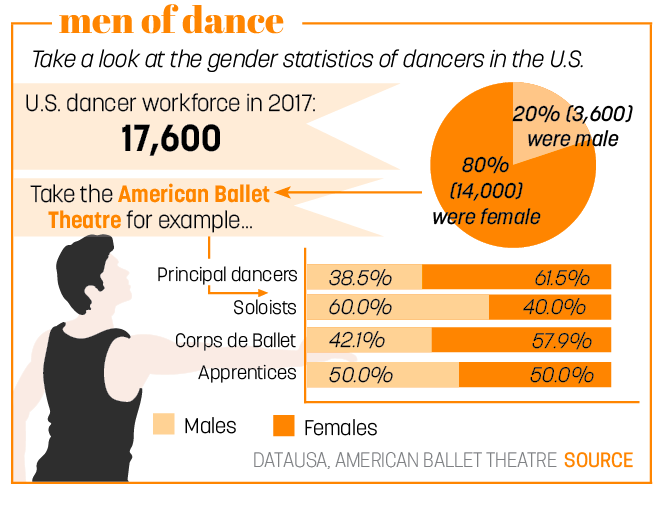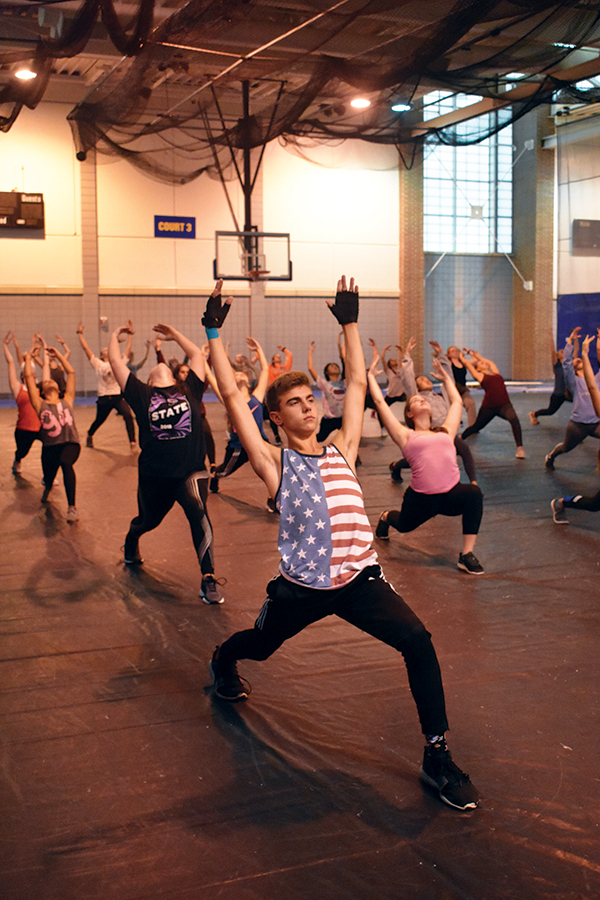With December approaching, dancers everywhere are beginning preparations for Nutcracker performances. Despite the importance of the male lead of the prince in this ballet, people still view dance as a feminine activity.
This is nothing new.
On Aug. 22, ABC’s “Good Morning America” (GMA) found itself facing controversy after host Lara Spencer mocked Prince George’s enjoyment for ballet. The segment on the show featured Prince George’s education schedule , which included ballet. “Prince William says Prince George absolutely loves ballet,” Spencer said regarding the show, as she and segments of the audience laughed. “I have news for you, Prince William: We’ll see how long that lasts.”

In the following days, #boysdancetoo began trending on Instagram. The hashtag served to unite male dancers and performers against these negative comments. Spencer apologized for her comments four days later.
“I screwed up, I did. The comment I made about dance was insensitive, it was stupid and I am deeply sorry,” she said. However, despite the apology, the #boysdancetoo hashtag is still used today.
Ballet teacher Sergey Sergiev from the Indiana Ballet Conservatory (IBC) said the GMA controversy was upsetting to see. “It is sad that people think that,” he said. “If they tried (it) and got a taste of it they’d have a completely different opinion. I did not think ballet was a serious thing, but once I started taking ballet my mind changed completely. You cannot judge a book by its cover.”
These types of negative comments are not unique to Prince George, as other male dancers and performers have received similar comments. Dancer and sophomore Damian Prabu, who dances in styles connected to hip hop, jazz and more, said, “Growing up, mostly in middle school, I got a lot of criticism for dancing. Now that I’ve come to high school I’ve received less.”

Matthew Beavan, color guard performer and junior, stretches during color guard practice in the fieldhouse. Beavan said he used to garner negative attention for being in color guard, but he has learned to ignore the comments. He is one of the main characters in the color guard’s set this year, titled Eternal Beloved.
Matthew Beavan, color guard performer and junior, said he had a similar experience to Prabu’s. “Not now, but (during) my freshman year I got a lot of (negativity) for being in (color guard). I just stopped paying attention to (those comments),” Beavan said. “Sophomore year I still had a couple people that were making fun of me for it, but I just stopped caring. This year no one’s giving me anything.”
Beavan said being one of two males in color guard has its unique pressures.
“You’re not just blending right into the crowd. You stand out,” he said. “It makes me more nervous, but (it) also is a good confidence booster when you know someone (is) watching you if you catch a toss really well, if you do a really cool trick, you know someone’s watching.”
Both Beavan and Prabu said while receiving criticism on traits such as their masculinity has been challenging, it was their passion for color guard and dance respectively that helped push them through tough times.
Sergiev said he had a different experience with dance as he grew up. Rather than being encouraging for him, he said, “Everybody thinks (dancers) should be female. But this is not really how it is. This was kind of pushing me away from ballet.”
Since starting to dance when he was 10, he changed his mind and has been doing ballet for 22 years. He said once he started, he saw the difficulty of dancing.
Prabu explained that this is because dancing is completely different from day-to-day life.
“It’s completely different from how normal life goes, because on stage I’m a completely different person. I just like the way (performing) feels.” Prabu said. “That and how I feel when I dance; it feels good when I do everything to the fullest no matter what people say.”
Beavan said he agress with Prabu and discussed experiences with tryouts.
“When you first (spin a rifle or gun correctly) you’re like, ‘What can I do next?’ Going to the tryouts really opened up the doors of what’s possible and next was just working up to it,” he said. He compared the experience to a “hunger” for improvement and seeing what he could do and how he could improve in his field.
Sergiev said he thinks the number of males participating in ballet at IBC has not changed much in recent years, but he said that he would love to see more boys get involved. Sergiev said dance is open to all to try and learn. He said, “Ballet is a fine art, it’s a very fine art for a reason and not every person is (going to) understand it. It takes time; it takes education. It is truly much harder than it looks.”
































![What happened to theater etiquette? [opinion]](https://hilite.org/wp-content/uploads/2025/04/Entertainment-Perspective-Cover-1200x471.jpg)














































![Review: “The Immortal Soul Salvage Yard:” A criminally underrated poetry collection [MUSE]](https://hilite.org/wp-content/uploads/2025/03/71cju6TvqmL._AC_UF10001000_QL80_.jpg)
![Review: "Dog Man" is Unapologetically Chaotic [MUSE]](https://hilite.org/wp-content/uploads/2025/03/dogman-1200x700.jpg)
![Review: "Ne Zha 2": The WeChat family reunion I didn’t know I needed [MUSE]](https://hilite.org/wp-content/uploads/2025/03/unnamed-4.png)
![Review in Print: Maripaz Villar brings a delightfully unique style to the world of WEBTOON [MUSE]](https://hilite.org/wp-content/uploads/2023/12/maripazcover-1200x960.jpg)
![Review: “The Sword of Kaigen” is a masterpiece [MUSE]](https://hilite.org/wp-content/uploads/2023/11/Screenshot-2023-11-26-201051.png)
![Review: Gateron Oil Kings, great linear switches, okay price [MUSE]](https://hilite.org/wp-content/uploads/2023/11/Screenshot-2023-11-26-200553.png)
![Review: “A Haunting in Venice” is a significant improvement from other Agatha Christie adaptations [MUSE]](https://hilite.org/wp-content/uploads/2023/11/e7ee2938a6d422669771bce6d8088521.jpg)
![Review: A Thanksgiving story from elementary school, still just as interesting [MUSE]](https://hilite.org/wp-content/uploads/2023/11/Screenshot-2023-11-26-195514-987x1200.png)
![Review: "When I Fly Towards You", cute, uplifting youth drama [MUSE]](https://hilite.org/wp-content/uploads/2023/09/When-I-Fly-Towards-You-Chinese-drama.png)
![Postcards from Muse: Hawaii Travel Diary [MUSE]](https://hilite.org/wp-content/uploads/2023/09/My-project-1-1200x1200.jpg)
![Review: "Ladybug & Cat Noir: The Movie," departure from original show [MUSE]](https://hilite.org/wp-content/uploads/2023/09/Ladybug__Cat_Noir_-_The_Movie_poster.jpg)
![Review in Print: "Hidden Love" is the cute, uplifting drama everyone needs [MUSE]](https://hilite.org/wp-content/uploads/2023/09/hiddenlovecover-e1693597208225-1030x1200.png)
![Review in Print: "Heartstopper" is the heartwarming queer romance we all need [MUSE]](https://hilite.org/wp-content/uploads/2023/08/museheartstoppercover-1200x654.png)



